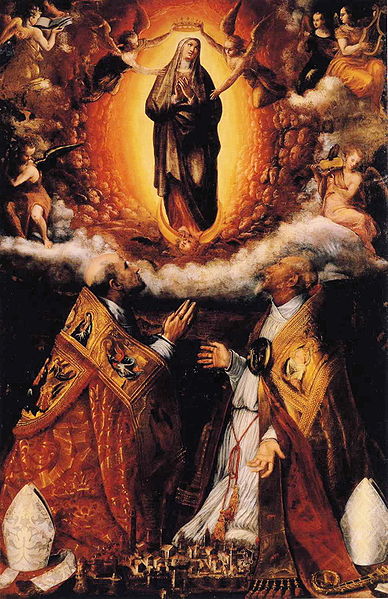By Livia Lupi
Lavinia Fontana died on 11 August 1614 in Rome. She was 62 years old. Women were typically excluded from artistic training in the Renaissance, but Lavinia was able to study with her father, the Bolognese Mannerist Prospero Fontana (d. 1597). She began her career in Bologna painting small devotional works like Christ with the Symbols of the Passion (1576) and portraits. Her first known self-portrait (1577) shows Lavinia at the spinet assisted by a maid holding the score, with an easel visible in the background. The easel informs us Lavinia is a painter by profession, but the painting also represents her as a cultured young woman with musical ability from a well-to-do background.
In 1577 she married Giovan Paolo Zappi, son of a wealthy merchant from Imola. They had eleven children, although eight of them did not make it to adulthood. After her wedding Lavinia continued to work relentlessly with the support of her husband, who managed the workshop’s finances.
In 1584 Fontana became the first woman to work on an altarpiece, an important public commission the commune of Imola assigned her. She depicted an Assumption of the Virgin witnessed by St Cassian and St Peter Chrysologus, patrons of Imola, kneeling at either side of a representation of the city.
Fontana executed several religious paintings, like her acclaimed Noli me tangere, and mythological works, like her Minerva Dressing. She ended her career in Rome, where she received prestigious commissions to provide altar decorations for the churches of San Paolo fuori le mura and Santa Maria della Pace.
Lavinia’s is the largest oeuvre of any woman prior to 1700.
Reference: “Fontana (ii): (2) Lavinia Fontana.” Grove Art Online. Oxford Art Online. Oxford University Press.
Vera Fortunati, “Fontana, Lavinia,” Dizionario biografico Treccani.
Further reading: Caroline Murphy. Lavinia Fontana: a Painter and Her patron in Sixteenth-Century Bologna. Yale University Press, 2003.
Paola Tinagli and Mary Rogers. Women in Italian Renaissance Art: Gender, Representation, Identity. Manchester University Press, 1997.
See also Anne Leader’s IAS Blog post commemorating Lavinia Fontana’s baptism: http://italianartsociety.tumblr.com/post/127487496368/by-anne-leader-lavinia-fontana-was-baptized-on-24
Noli me tangere, 1581, oil on canvas. Florence, Galleria degli Uffizi
Self-Portrait in a Studio, 1579, oil on copper. Florence, Galleria degli Uffizi
Gozzadini Family, oil on canvas, 1584. Bologna Pinacoteca Nazionale
Self-portrait at the Spinet, 1577, oil on canvas. Rome, Accademia di San Luca
Head of a Youth, 1606, tempera and watercolor on paper. Rome Galleria Borghese
Minerva Dressing, 1613, oil on canvas. Rome, Galleria Borghese
Christ with the Symbols of the Passion, 1576, oil on canvas. El Paso, Museum of Art
Assumption of the Virgin, 1584, oil on canvas. Imola, Pinacoteca nazionale








